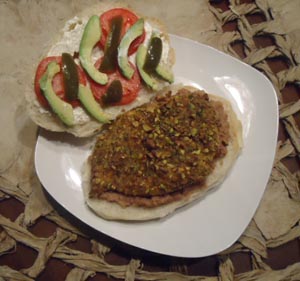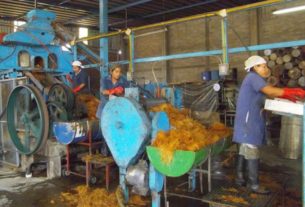Mexican Kitchen

Although it is tempting to describe a fellow human as Nut of the Year (as in “My landlord is crazy, he’s gotta be nut of the year”), in this case, we’re referring to the pistachio, which has been named Nut of the Year 2015 by Baum and Whiteman, a food consulting company that follows culinary trends and lets the rest of us know which ones are the hottest.
When I read this kind of pronouncement, I tend to think in terms of how it might apply to Mexico and, sure enough, a little research reveals that pistachios are indeed one of the country’s up and coming crops. An article in the Chihuahua newspaper El Parral, enthusiastically titled “Pistachio Trees: Planting Hope” (“Pistachos: La Siembra de la Esperanza,” August 13, 2012) explains that the Northern Mexican climate of Chihuahua is ideal for pistachio trees, which require only half as much water as the more common pecan trees and can survive drought conditions.
I knew that a dry climate can indeed support pistachio trees because a friend in Oaxaca bought one as a sapling some years back and it has flourished in the semi-arid Oaxacan climate, bearing fruit after the first five years or so. This is about right, although the trees do not yield significant amounts for the first 10-15 years. So, the author of that newspaper article was probably right in calling the cultivation of pistachios an investment in the future.
Further research led to the fact that February 26 is Pistachio Day. This holiday is undoubtedly part of a US ad campaign rather than a worldwide observance but, still, it’s another occasion to celebrate. Maybe we could whip up some kind of pistachio cocktail? Probably not, but there are other uses for pistachios besides eating them out of a bowl, and they appear in both sweet and savory dishes in the Mexican culinary repertoire.
The first thing that comes to mind is, of course, a visit to the local helados shop, where pistachio is among the favorite ice cream flavors — usually colored a pastel green but, in better quality ice cream, left without the dubious tint of artificial color. Of course, the green color does play a certain role and, even before most kids can read, they know that the green ice cream is pistache.
Pistachios are also a popular ingredient in the polvorones known outside Mexico as “Mexican wedding cookies.” I have never been to a wedding in Mexico where these are actually served, but I have tried making them with pistachios instead of pecans, with good results. Pistachios are also used in mazapanes, the Mexican nut candies made with pecans, almonds or pistachios, and make good palanquetas, or nut brittle.
In the savory department, pistachios make a delicious mole ingredient and — combined with cilantro — a unique pesto, especially with chicken, whose mild flavor is a good foil for the rich herb-and-nut combination.
The pistachio (Pistacia vera), a member of the cashew family, is a native of the Middle East and has been consumed since about 7,000 BC. This ancient, flowering nut tree was introduced into Europe by Roman consuls in Syria, and spread throughout the Mediterranean region.
Introduced into the US in the 1850s, pistachios flourished in Texas and California but were not planted as a commercial crop in Mexico until over a century later, when a study by CIRENA (Centro de Investigaciones de Recursos Naturales) proved the pistachio to be a viable option for northern Mexican farmers. In addition to needing little water, it commands more money in the market than many other tree nuts. In a sensory analysis test done under the aegis of the UN Food and Agriculture Organization, the pistachios produced in Delicias, Chihuahua compared favorably with those grown in the US and Iran (the world’s largest pistachio producer.)
The part of the nut that we eat is actually the seed of a reddish, wrinkled “fruit” that grows in clusters, something like grapes. The pistachio is technically considered a drupe, or stone fruit, like the mango, to which it is related. When this epicarp comes off, as the nut ripens, the nutshell splits, a characteristic that makes shell-on pistachios so easy to shell and eat.
Besides being delicious, pistachios are cholesterol free and high in fiber. A one ounce serving provides 10 percent of an adult’s daily protein requirement, and pistachios are an excellent source of antioxidants and oleic acid, which lowers the “bad” LDL cholesterol levels and raises the HDL. Like all nuts, pistachios are calorie dense, and it is important to pay attention to portion size. A healthy, 100 calorie serving of pistachios consists of 1/3 cup without shells (about 28 shell-on nuts.)
Pistachios are freshest in the fall, when they are harvested and sold — shelled or unshelled, raw or roasted, salted or unsalted. Like other nuts, pistachios have volatile oil and should be stored in airtight containers. Shelled or unshelled, they keep in the refrigerator for three months. With shells on, they can be stored in the freezer for up to a year.
Sometimes you will encounter a pistachio shell that hasn’t split enough to open easily. Don’t throw away this morsel of deliciousness. Use an empty shell half as leverage to get in the crack and open by inserting and twisting.
And don’t worry about your hands turning red, because most pistachios today are harvested mechanically, eliminating the need to use dye to cover stains on the shell that came from hand harvesting. (As kids, the red color was part of the pistachio mystique. Did anyone else glue the red shell halves to their fingernails and pretend they had long, red nails? No? They were also good for making pretend “lipstick.”)
Speaking of color, as for the greenish hue of the nut itself, according to food scientist Harold McGee, it simply comes from chlorophyll, as in many other plant foods. Among nuts, the pistachio is unique in this characteristic, and the cooler the climate in which it is grown, the deeper green the color will be.
Pistachios are versatile in the kitchen and, in addition to their use in cookies, ice cream and nut brittle, are great in salads, either raw, roasted, or candied in the style called garapiñado in Mexico. In salads, they go especially well with fresh pears or apples, or with dried fruit.
Pistachios are also good ground and used as a crust for chicken breasts, fish filets and scallops, whether your preparation involves baking, sautéing or grilling. So grab a handful of pistachios and unleash your culinary creativity with the Nut of the Year.
- Mexican pear and candied pistachio salad with honey chipotle vinaigrette: Ensalada de pera y pistache garapiñada con vinaigreta de miel y chipotle
- Mexican pistachio cilantro pesto: Pesto de pistache y cilantro
- Mexican pistachio crusted chicken breast: Pechuga de Pollo con costra de pistache
- Crumbly Mexican pistachio cookies: Polvorones de pistache

